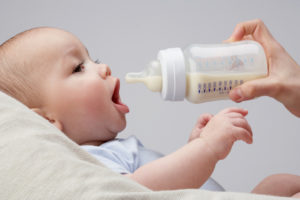 Adoptive parents have two main options when it comes to feeding their baby: formula or breastfeeding. Both methods are nutritious for your baby, and each has its own advantages and disadvantages, so the decision really comes down to what works best for you.
Adoptive parents have two main options when it comes to feeding their baby: formula or breastfeeding. Both methods are nutritious for your baby, and each has its own advantages and disadvantages, so the decision really comes down to what works best for you.
To help you make a decision, we have compiled some formula information that you may not know. Be sure to check out our post on breastfeeding an adopted child, as well!
What Exactly is Baby Formula?
Infant formula is a nutritional supplement that is usually milk-based. For infants who have lactose intolerances, soy-based formulas also exist.
What Should I Know about Formula Feeding?
When it comes to purchasing formula, you have many options. Formula can be purchased pre-mixed, powdered, or concentrated – all of which are equally good for the baby as long as you follow the instructions. When looking for a formula, make sure it contains iron, DHA, and ARA, all of which will help baby’s healthy growth.
After purchasing formula, one of the most common questions parents have is how to know when to feed their baby. In general, infants are usually fed every three or four hours and should be given two to three ounces of formula per pound of body weight.
Formula that is not pre-mixed should be prepared with cold water, and many parents choose to warm up the bottle before feeding the baby. Because microwaves cause uneven heating, you should not use the microwave for this step. Make sure you throw away whatever your baby does not drink, as saving leftovers can cause a buildup of bacteria.
Just like with breastfeeding, formula feeding can also be a great time to bond with your baby. Eye contact, talking, and switching arms are just a few of the ways to make feeding a positive experience for you and your baby.
What are the Advantages and Disadvantages of Formula Feeding?
Here are just a few of the benefits and drawbacks to choosing formula:
Pros:
- Less physically demanding – There is no question that breastfeeding takes a physical toll on a mother, especially if you experience any difficulties with producing milk.
- All family members can help feed – Bottle feeding offers the added bonus of allowing dad, grandma, or anyone else to feed and bond with the baby.
Cons:
- Extra items needed – Buying bottles and formula can sometimes be costly, and it takes time to clean the bottles after feeding. However, adoptive breastfeeding also requires additional time and expenses.
- Nutrition – Formula has come a long way in replicating human breastmilk; however, there are still some properties that have yet to be replicated using formula. That being said, formula fed babies grow into happy health adults just as breastfed babies do. Ultimately, though, the best method is the one that is healthiest for both of you.
How do I Decide?
Some mothers know from the beginning that formula will work better for them and their baby. Others may try breastfeeding and switch to formula later. By weighing the pros and cons listed here and possibly trying for yourself, you will be able to figure out the best solution for you and your baby.


